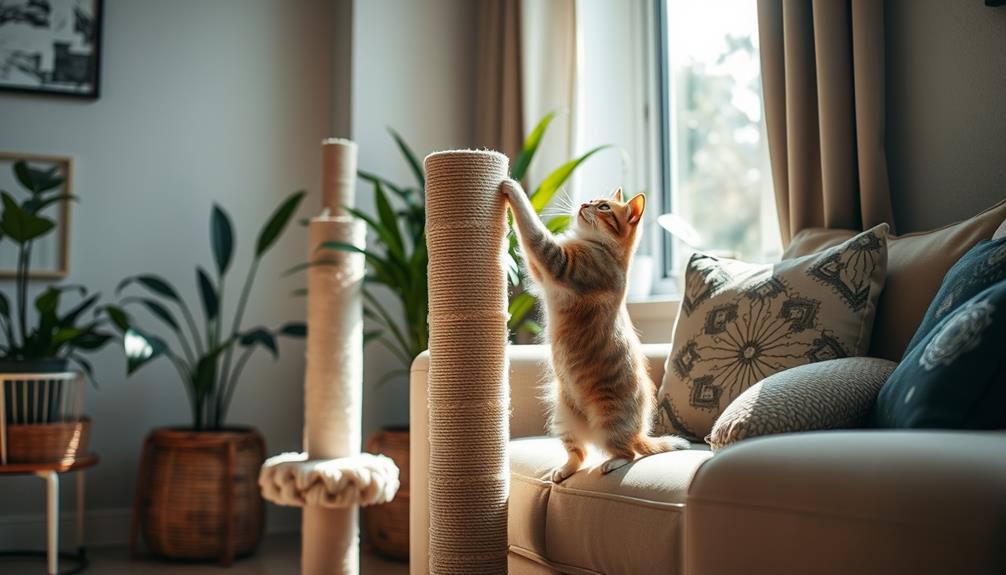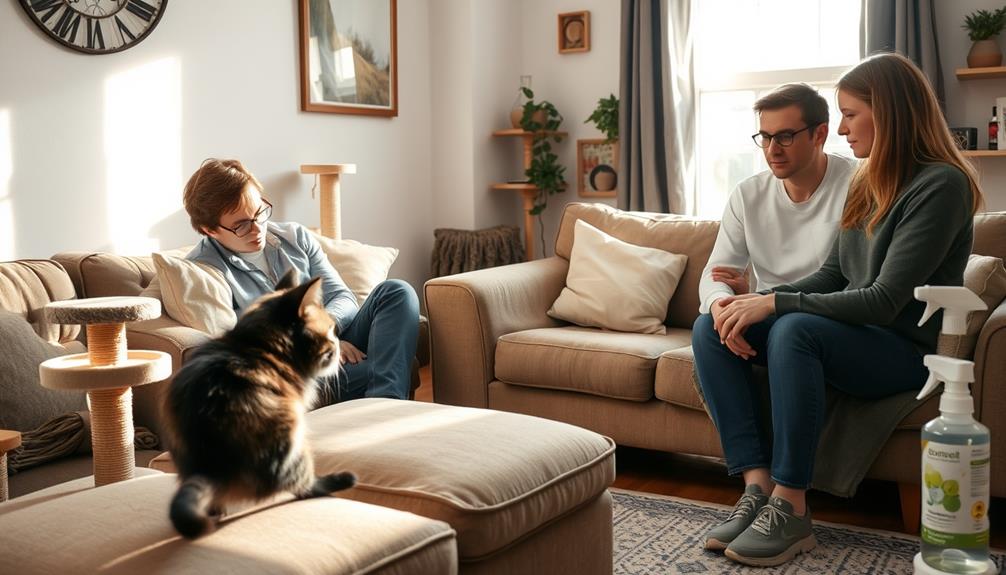To prevent your cat from scratching furniture, it is essential to provide designated scratching posts. Opt for durable options and place them in high-traffic areas close to your furniture. Spark your cat’s interest by incorporating catnip or treats, and be sure to reward them when they use the posts. Gently guide them to the scratching posts if you see them scratching furniture. You can also consider using double-sided tape to cover scratched areas or citrus sprays to deter them. Regularly trimming their nails can also help reduce damage. Exploring additional strategies can contribute to establishing a peaceful atmosphere for both you and your cat.
Key Takeaways
- Provide sturdy scratching posts in high-traffic areas to encourage use instead of furniture.
- Use positive reinforcement, rewarding cats with treats when they use scratching posts.
- Redirect cats gently to scratching posts if they scratch furniture, maintaining a calm demeanor.
- Make furniture less appealing by applying double-sided tape or using citrus-based repellents.
- Regularly trim cat nails to minimize damage and consider using nail caps for added protection.
Understanding Cat Scratching Behavior
When it comes to understanding cat scratching behavior, it's important to recognize that this instinct is completely natural. Your cat scratches for several reasons, and knowing these can help you manage their behavior effectively.
First, scratching is fundamental for maintaining their claws. As your cat scratches, they shed the outer layers, keeping their claws sharp and healthy, which is essential for their overall health.
Additionally, scratching serves as a full-body exercise, helping relieve muscle tension and anxiety. This physical activity is significant for your cat's mental wellbeing.
Cats often prefer vertical surfaces like furniture because it allows them to stretch fully while marking their territory. They leave visual and chemical signals to communicate their presence to other cats.
To guarantee your cat's health and well-being, it's also important to take into account their overall nutrition, as a balanced diet can impact their behavior.
Understanding this behavior can shift your perspective. Instead of viewing scratching as destructive, see it as a necessary outlet for your cat.
Importance of Scratching Posts

Investing in scratching posts is essential for both you and your cat. These posts provide a designated area for your feline friend to engage in their normal behavior, which includes scratching and stretching. To keep your cat happy and healthy, choose a scratching post with a sturdy base that can withstand vigorous use.
It's a good idea to place a scratching post in high-traffic areas or near furniture that your cat tends to scratch. This positioning encourages your cat to use the post instead of your couch or chairs. Additionally, just like how essential oils can be used to promote well-being, offering a comfortable and inviting scratching environment can enhance your cat's overall happiness and reduce stress-related behaviors. essential oils for calming
Consider offering various types of scratching surfaces, like sisal, carpet, and cardboard, to cater to your cat's preferences. Adding catnip on the post can further entice them to engage with it. You might also want to explore cat trees that incorporate scratching posts, adding height and excitement to their scratching experience.
To maintain your cat's interest, regularly rotate the location of the scratching posts and introduce new styles. This variety keeps your cat engaged and reinforces their scratching habits in the appropriate areas, ultimately protecting your furniture while keeping your cat satisfied.
Training Techniques for Cats

To effectively train your cat to stop scratching furniture, you'll want to focus on positive reinforcement methods, strategically placing scratching posts, and gentle redirection strategies. To encourage your cat to use the scratching posts instead of the furniture, you can sprinkle catnip on the posts or use a pheromone spray to attract them. Additionally, you can use double-sided tape or aluminum foil to prevent cat scratching on the furniture by making it an unappealing surface for them. It’s important to remember that patience and consistency are key when training your cat, so be sure to reinforce positive behavior and gently redirect them away from the furniture whenever necessary.
Rewarding your cat for using the posts can create a habit they'll love. Incorporating natural ingredients in treats may also encourage your cat to engage with their designated scratching areas.
Plus, with the right placement and gentle nudges, you can guide them away from your furniture without stress.
Positive Reinforcement Methods
One effective way to train your cat to stop scratching furniture is through positive reinforcement methods.
Start by using high-value treats and praise every time your cat uses the scratching post instead of your furniture. This creates a positive association with the desired behavior. You can also implement clicker training; click at the moment your cat scratches the right surface and follow up with a reward. This technique reinforces the behavior more effectively.
When you catch your cat scratching your furniture, gently redirect your cat to the scratching post. Immediately reward your cat when they comply, reinforcing the new habit.
Experiment with enticing your cat to the scratching post using catnip or interactive toys. This encourages them to engage with the post rather than the furniture.
To truly succeed, maintain consistency in your training. Regularly reward your cat for appropriate scratching to establish a routine.
Scratching Post Placement
Placing scratching posts strategically is a key part of training your cat to stop scratching furniture. Start by locating a scratching post near the areas where your cat likes to scratch. This encourages them to use the designated post instead of your couch or chairs.
Make sure the post is tall and sturdy, allowing your cat to fully stretch while they scratch. Cats prefer vertical surfaces, so a well-placed post can greatly influence their scratching behaviors.
Experiment with different materials, like sisal, carpet, or cardboard, to discover what your cat likes to scratch the most. You might also consider incorporating catnip or toys around the scratching post to make it more appealing. This can entice your cat to use the post instead of your furniture.
Additionally, regularly rotate the location of the scratching post to keep it interesting and maintain your cat's engagement.
Gentle Redirection Strategies
While you may find it frustrating when your cat scratches your furniture, gentle redirection can effectively teach them to use scratching posts instead. Here are some strategies you can try:
- Use positive reinforcement: Reward your cat with treats or praise when they use the scratching posts.
- Gently redirect: Calmly guide your cat to the scratching post when you catch them scratching furniture, using a soft clap or a soothing voice to get their attention.
- Incorporate interactive play: Engage your cat in play near the scratching posts to draw their attention away from the furniture.
- Experiment with textures: Different cats have individual preferences, so offering various scratching post materials can help in redirecting their behavior.
Maintain consistency in your training approach, ensuring all household members are on the same page regarding redirecting behavior.
This way, your cat will learn that scratching posts lead to positive outcomes, while furniture is off-limits.
Redirecting Scratching to Alternatives

To effectively redirect your cat's scratching behavior away from furniture, start by providing sturdy scratching posts made from appealing materials like sisal or cardboard.
These preferred materials can greatly entice your cat to use them instead. Position the scratching posts in high-traffic areas and near the furniture that your cat tends to scratch. This strategic placement encourages your cat to engage with the posts and mark their territory.
You can enhance the appeal of the scratching posts by sprinkling catnip on them or placing treats nearby. This approach can motivate your cat to explore the new options rather than continue cat scratching furniture.
Observing your cat and rewarding positive behavior when they use the scratching post reinforces this desired behavior.
Don't hesitate to experiment with different types of scratching surfaces, including both vertical and horizontal options. Your cat may have a preference, and trying various styles can improve the likelihood of successful redirection.
Enhancing Your Cat's Environment

Frequently enhancing your cat's environment can greatly reduce unwanted scratching behavior. By creating a stimulating space, you provide your feline friend with the mental engagement they crave. Here's how you can do it:
- Provide a variety of scratching posts made from different materials like sisal, cardboard, and wood.
- Invest in cat trees and climbing shelves to encourage exploration and exercise.
- Incorporate interactive toys to keep your cat entertained and engaged.
- Position scratching posts strategically in high-traffic areas and near furniture they typically scratch.
These steps can redirect your cat's scratching behavior to more appropriate items.
Regularly rotating toys and introducing new activities will keep your cat mentally stimulated, alleviating boredom and stress.
Adding elements such as window perches or outdoor enclosures (catios) offers additional enrichment and exercise opportunities.
When you create a rich, engaging environment, you help satisfy your cat's natural instincts, reducing the likelihood of destructive scratching.
Making Furniture Less Attractive

Creating a stimulating environment for your cat can help reduce unwanted scratching, but it's also important to make your furniture less appealing. Start by applying double-sided sticky tape to the surfaces—cats generally dislike the sticky sensation on their paws.
You can also use aluminum foil or plastic covers to create an unpleasant texture that deters them from scratching your furniture.
Another effective tactic is to spray furniture with citrus or vinegar-based solutions. These aversive scents can help prevent cats from returning to their favorite scratching spots.
Regularly cleaning furniture is essential too; it eliminates lingering scents that might encourage your cat to scratch the same areas.
If your cat has specific furniture they favor, consider blocking access by rearranging the layout or using barriers. This can redirect their behavior and encourage them to use cat scratching posts instead.
By combining these strategies, you'll make your furniture less attractive to your cat, allowing you both to enjoy a scratch-free home.
Nail Care and Maintenance

Keeping your cat's nails well-maintained is essential for both their health and your furniture's longevity. Regular nail trimming every 2-4 weeks minimizes scratching damage, making it less likely for those sharp claws to snag on upholstery.
Here are some tips to help you manage your cat's nail care:
- Use pet-specific nail clippers to safely trim the tips of your cat's claws.
- Apply nail caps, like Soft Paws, to soften the impact of scratching while allowing natural behavior.
- Provide a scratching post or pad to satisfy your cat's instinct to scratch.
- Monitor their nail growth and adjust your trim schedule based on their activity level.
When you trim your cat's nails, avoid the quick—the pink area containing blood vessels—to prevent pain and bleeding.
Keep an eye on your cat's behavior; if they're scratching more frequently, it might be time for an extra trim. Encouraging the use of cat toys and a scratching post not only helps maintain nail health but also diverts their attention away from your furniture.
Prioritize nail care, and you'll see a positive change in both your cat's behavior and your home.
Avoiding Harmful Practices

When it comes to managing your cat's scratching habits, avoiding harmful practices is essential for their well-being. Declawing is one of the most detrimental options; it's a painful surgical procedure that removes the last bone of each toe, leading to long-term physical and behavioral issues.
Many veterinary organizations and animal welfare groups label declawing as inhumane, and they promote humane alternatives for managing scratching behavior.
Instead of punishing your cat for scratching, which can create fear and anxiety, consider gentle redirection to appropriate scratching surfaces. Using positive reinforcement, like treats and praise, encourages your cat to scratch where you want them to.
Additionally, products like claw caps (e.g., Soft Paws) can help protect your furniture from damage while still allowing your cat to engage in their natural scratching behavior.
Seeking Professional Help

If your cat's scratching persists despite your best efforts, it might be time to seek professional help.
Consulting a Certified Applied Animal Behaviorist or a veterinary behaviorist can provide tailored strategies and assess any underlying issues.
These experts can help you understand your cat's behavior and guide you in redirecting it effectively.
Behaviorist Consultation Benefits
Consulting a Certified Applied Animal Behaviorist can greatly enhance your approach to curbing your cat's scratching habits. A behaviorist consultation provides you with tailored strategies that directly address your cat's unique scratching behavior.
Here are some key benefits:
- Personalized Training Plans: Behaviorists create specific training plans based on your cat's individual needs.
- Home Environment Assessment: They'll evaluate your home environment to identify stressors contributing to scratching.
- Enrichment Recommendations: Expect expert advice on enriching your cat's surroundings to minimize destructive behavior.
- Evidence-Based Techniques: Professionals employ proven methods that lead to long-term success, avoiding the pitfalls of trial-and-error.
With their expertise, behaviorists can help you tackle underlying behavioral issues that may cause your cat to scratch.
They observe your cat in its natural setting, ensuring that the strategies you implement are effective and sustainable.
Engaging a behaviorist not only saves you time and reduces frustration but also equips you with the tools needed for consistent training.
Veterinary Advice Options
Seeking veterinary advice can be a game changer when it comes to addressing your cat's scratching habits. Consulting a veterinarian can reveal underlying behavioral issues like anxiety or boredom that contribute to excessive scratching. Here's a quick overview of what you might consider when seeking professional help:
| Option | Description | Benefits |
|---|---|---|
| Consulting a Veterinarian | Get insights on behavioral issues and treatments. | Identify causes of scratching. |
| Veterinary Behaviorist | Specialized help for complex behaviors. | Develop a tailored plan for your cat. |
| Calming Supplements | Medications to reduce anxiety. | Manage stress-related scratching effectively. |
| Proper Nail Trimming | Techniques demonstrated by the veterinarian. | Minimize potential furniture damage. |
| Telehealth Services | Quick consultations without in-person visits. | Convenient and efficient advice. |
A veterinary behaviorist can create a tailored plan to modify your cat's behavior. Plus, they can recommend calming supplements to help manage stress-related scratching. Don't hesitate to reach out to your vet; they've got the expertise to help you and your feline friend.
Additional Resources for Cat Owners

As a cat owner, you can tap into a wealth of resources to help manage your feline's scratching habits. Addressing your cat's need to scratch while protecting your furniture is achievable with the right strategies and support.
- Veterinary Clinics: Many offer free video consultations for advice on managing scratching behavior.
- Online Resources: Articles and FAQs can provide valuable tips on understanding and addressing scratching issues effectively.
- Newsletters: Subscribing to updates from veterinary professionals keeps you informed about the latest strategies for promoting positive scratching behavior.
- Community Support: Engaging with local pet behaviorists or shelters can offer additional insights into managing your cat's scratching habits.
Utilizing products like Soft Paws claw caps can be a humane alternative to declawing, allowing your cat to maintain its natural scratching behavior without damaging your furniture.
Additionally, investing in a suitable scratching post can redirect your cat's attention and encourage positive scratching behavior.
Frequently Asked Questions
How Do I Stop My Cat From Scratching My Couch?
To stop your cat from scratching your couch, provide sturdy scratching posts, use unpleasant textures on the couch, apply aversive scents, trim their claws regularly, and reward them when they use the scratching post.
What Deters Cats From Scratching Furniture?
To deter cats from scratching furniture, use double-sided tape, citrus sprays, or aluminum foil. Provide engaging scratching posts and consider motion-activated deterrents to startle them. These methods will help keep your furniture safe.
Can You Train a Cat to Not Scratch Furniture?
Yes, you can train your cat not to scratch furniture. Redirect their behavior by providing scratching posts, using positive reinforcement like treats, and engaging them with toys. Consistency and patience are key to successful training.
What Can I Spray on My Sofa to Stop My Cat Scratching It?
"You can't teach an old dog new tricks," but you can spray your sofa with diluted citrus, vinegar solution, or a commercial deterrent. Cats often dislike these scents, helping protect your furniture from scratches.
Conclusion
By understanding your cat's natural instincts and providing suitable alternatives, you can protect your furniture while keeping your feline happy. For example, consider the case of Sarah, who introduced a tall scratching post near her couch. Within weeks, her cat Milo preferred the post, saving her furniture from further damage. With a little patience and the right tools, you can create a harmonious home for both you and your furry friend.









